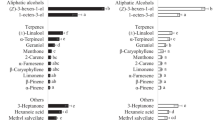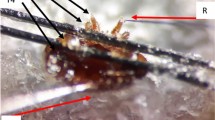Abstract
The pygidial gland secretions of Neotropical dung roller beetles appear to function as defensive agents against predator ants. Behavioral and electrophysiological tests were used to evaluate the responses of the ant Camponotus sericeiventris to pygidial compounds secreted by the dung roller beetles Canthon cyanellus cyanellus and Canthon femoralis femoralis (Coleoptera: Scarabaeidae). Our behavioral investigation revealed a lower aggressive response of C. sericeiventris to the dung roller beetles compared to their response to the fly Anastrepha ludens. Additionally, C. sericeiventris workers attacked C. f. femoralis more often than C. c. cyanellus. The behavioral aggression of C. sericeiventris was greater toward male than female C. c. cyanellus. Electroantennography showed that the antennae of C. sericeiventris react to pygidial extracts from C. c. cyanellus and C. f. femoralis. Three compounds from male and female C. f. femoralis and C. c. cyanellus elicited coupled gas chromatography-electroantennogram (GC-EAD) activity in the antennae of C. sericeiventris. Geraniol and an unknown compound (A) were specific for C. f. femoralis, whereas guaiacol and another unknown compound (B) were specific to C. c. cyanellus; phenol was shared by both beetle species. This is the first report confirming that the pygidial gland secretions of dung roller beetles play a role in their defense against predators.







Similar content being viewed by others
References
Alabi T, Dean J, Michaud JP, Verheggen F, Lognay G, Haubruge E (2011) Does Tribolium brevicornis cuticular chemistry deter cannibalism and predation of pupae? J Insect Sci 11:115. http://insectscience.org/11.115
Aziz EE, Abbass MH (2010) Chemical composition and efficiency of five essential oils against the pulse beetle Collosobruchus maculates (F) on Vigna radiate seeds. Am Eurasian J Agric Environ Sci 8(4):411–419
Blum MS (1981) Chemical defenses of arthropods. Academic Press, New York
Campbell C, Gries R, Gries G (2010) Forty-two compounds in eleven essential oils elicit antennal responses from Aedes aegypti. Entomol Exp Appl 138:21–32
Cortez V, Favila ME (2007) Actividad antifúngica del ácido 4-metoxi fenilacético producido en las glándulas esternales de machos del escarabajo rodador Canthon cyanellus cyanellus (Coleoptera Scarabaeinae). Entomol Mex 6(1):355–359
Coster-Longman C, Landi M, Turillazzi S (2002) The role of passive defense (selfish herd and dilution effect) in the gregarious nesting of Liostenogaster wasps Vespidae, Hymenoptera, Stenogastrinae). J Insect Behav 15(3):331–350
Dettner K (1985) Ecological and phylogenetic significance of defensive compounds from pygidial glands of Hydradephaga (Coleoptera). Proc Acad Nat Sci Phila 137:156–171
Evans DL, Schmidt JO (1990) Insect defenses: adaptive mechanisms and strategies of prey and predators. State University of New York Press, Albany
Favila ME (1988) Comportamiento durante el periodo de maduración gonádica en un escarabajo rodador (Coleoptera: Scarabaeidae, Scarabaeinae). Folia Entomol Mex 76:55–64
Favila ME (1993) Some ecological factors affecting the life-style of Canthon cyanellus cyanellus (Coleoptera: Scarabaeidae): an experimental approach. Ethol Ecol Evol 5:319–328
Favila ME (2001) Ecología química en escarabajos coprófagos y necrófagos de la subfamilia Scarabaeinae. In: Anaya AL, Espinosa FJ, Cruz R (eds) Relaciones químicas entre organismos: Aspectos básicos y perspectivas de su aplicación. Editorial Plaza y Valdés, SA de CV, pp 541–580
Favila ME, Díaz A (1993) Comportamiento cooperativo y subsocial de Canthon cyanellus cyanellus LeConte (Coleoptera: Scarabaeidae). Instituto de Ecología, AC Video documentary in VHS format (8 mm)
Favila ME, Díaz A (1996) Canthon cyanellus cyanellus LeConte (Coleoptera: Scarabaeidae) makes a nest in the field with several brood balls. Coleopts Bull 50(1):52–60
Francke W, Dettner K (2005) Chemical signalling in beetles. In: Schultz S (ed) Chemistry of pheromones and other semiochemicals II. Top Curr Chem, pp 85–166
Grover CD, Adam DK, Monson JA, Marsh TC, Holway DA (2007) Linking nutrition and behavioural dominance: carbohydrate scarcity limits aggression and activity in argentine ants. Proc R Soc B 274:2951–2957
Halffter G (1997) Subsocial behavior in Scarabaeinae beetles. In: Choe JC, Crespi BJ (eds) The evolution of social behavior in insects and arachnids. Cambridge University Press, Cambridge, pp 237–259
Halffter G, Matthews EG (1966) The natural history of dung beetles of the subfamily Scarabaeinae (Coleoptera, Scarabaeidae). Folia Entomol Mex 12(14):1–312
Halffter G, Edmonds WD (1982) The nesting behaviour of the dung beetles (Scarabaeinae). An ecological and evolutive approach. Instituto de Ecología, México
Halffter G, Halffter V, Huerta C (1983) Comportement sexual et nidification chez Canthon cyanellus cyanellus LeConte. Bull Soc Entomol Mex 88:585–594
Hashimoto Y (1990) Unique features of sensilla on the antennae of formicidae (Hymenoptera). Appl Entomol Zool 25:491–501
Henaut Y, Pablo J, Ibarra-Nuñez G, Williams T (2001) Retention, capture and consumption of experimental prey by orb-web weaving spiders in coffee plantations of Southern Mexico. Entomol Exp Appl 98:1–8
Hölldobler B, Wilson EO (1990) The Ants. The Belknap Press of Harvard University, MA
Iwata K (1976) Evolution of instinct: comparative ethology of Hymenoptera. Amerind, New Delhi
Kanehisa K, Tsumuki H (1996) Pygidial secretion of Stenus rove beetles (Coleoptera: Staphilinidae). Bull Res Inst Bioresour 4:25–31
Leuthold RH, Schlunegger U (1973) The alarm behavior from the mandibular gland secretion in the ant Cremastogaster scutellaris. Insect Soc 20(3):205–214
Löfqvist J (1976) Formic acid and saturated hydrocarbons as alarm pheromones for the ant Formica rufa. J Insect Physiol 22:1331–1345
Martini R, Schmidt K (1984) Ultrastructure and early development of the pore plate sensilla of Gymnomerus laevipes (Shugkard) (Vespoidea, Eumenidae). Protoplasma 119:197–211
Matthews EG (1965) The taxonomy, geographical distribution, and feeding habits of the Canthonines of Puerto Rico (Coleoptera: Scarabaeidae). Trans Am Entomol Soc 91:431–465
Mitchell BK, Itagaki H, Rivet MP (1999) Peripheral and central structures involved in insect gestation. Microsc Res Techniq 47:401–415
Montes de Oca E, Martínez I, Cruz M, Favila ME (1991) Observaciones de campo sobre el comportamiento y madurez gonádica en Canthon indigaceus chevrolati Harold (Coleoptera: Scarabaeidae). Folia Entomol Mex 83:69–86
Nowbahari E, Fénéron R, Malherbe MC (1999) Effect of body size on aggression in the ant Cataglyphis niger (Hymenoptera: Formicidae). Aggressive Behav 25:369–379
Pasteels JM, Gregoire JC, Rowell-Rahier M (1983) The chemical ecology of defense in arthropods. Annu Rev Entomol 28:263–289
Pearson DL, Blum MS, Jones TH, Fales HM, Gonda E, White BR (1988) Historical perspective and the interpretation of ecological patterns: defensive compounds of tiger beetles (Coleoptera: Cicindelidae). Am Nat 132(2):404–416
Pluot-Sigwalt D (1982) Diversité et dimorphisme sexuel de glandes tégumentaires abdominales chez les Coléopteres Scarabaeidae. CR Acad Sci 294:945–948
Pluot-Sigwalt D (1983) Les glandes tégumentaires des Coléopteres Scarabaeidae: répartition des glandes sternales et pygidiales dans la famille. Bull Soc Entomol Fr 88:597–602
Pluot-Sigwalt D (1988a) Le système des glandes tegumentaires des Scarabaeidae rouleurs, particulierement chez deux especes de Canthon (Coleoptera). Folia Entomol Mex 74:79–108
Pluot-Sigwalt D (1988b) Données sur l’activité et le role de quelque glandes tegumentaires, sternales, pygidiales et autres, chez deux especes de Canthon. Bull Soc Entomol Fr 93:89–98
Pluot-Sigwalt D (1991) Le système glandulaire abdominal des coléopteres coprophages Scarabaeidae: ses tendances évolutives et ses relations avec la nidification. Ann Soc Entomol Fr 27:205–229
R Development Core Team (2010) R: a language and environment for statistical computing. R Foundation for Statistical Computing, Vienna Austria. http://www.R-project.org
Schneider D (1964) Insect antennae. Annu Rev Entomol 9:103–122
Schultz TM, Puchalski YJ (2001) Chemical defenses in the tiger beetle Pseudoxycheila tarsalis Bates (Carabidae: Cicindelinae). Coleopts Bull 55(2):164–166
Skelhorn J, Ruxton GD (2007) Ecological factors influencing the evolution of insects’ chemical defenses. Behav Ecol 19(1):146–153
StatSoft Inc. (2006) STATISTICA (data analysis software), version 7.1 StatSoft Inc., Tulsa
Suckling DM, Karg G, Gibb AR, Bradley SJ (1996) Electroantennogram and oviposition responses of Epiphyas postvittana (Lepidoptera: Tortricidae) to plant volatiles. N Z J Crop Hortic Sci 24:323–333
Taira J, Nakamura K, Higa Y (2003) Identification of secretory compounds from the millipede, Oxidus gracilis C.L. Koch (Polydesmida: Paradoxosomatidae) and their variation in different habitats. Appl Entomol Zool 38:401–404
Traina O, Cafarchia C, Capelli G, Iacobellis NS, Otranto D (2005) In vitro acaricidal activity of four monoterpenes and solvents against Otodectes cynotis (Acari: Psoroptidae). Exp Appl Acarol 37:141–146
Tschinkel WR (1969) Phenols and quinines from the defensive secretions of the tenebrionid beetle, Zophobas rugipes. J Insect Physiol 15:191–200
Whiting MJ, Godwin W (1998) Pogonomyrmex Mayr harvester ants (Hymenoptera: Formicidae): an additional cost associated with dung beetle, Canthon imitator Brown (Coleoptera: Scarabaeidae), reproduction? Coleopts Bull 52:157–160
Witz BW, Mushinsky HR (1989) Pygidial secretions of Pasimachus subsulcatus (Coleoptera: Carabidae) deter predation by Eumeces inexpectatus (Squamata: Scineidae). J Chem Ecol 15(3):1033–1044
Yamamoto M, Del-Claro K (2008) Natural history and foraging behavior of the carpenter ant Camponotus sericeiventris Guérin, 1938 (Formicinae, Camponitini) in the Brazilian tropical savanna. Acta Ethol 11:55–65
Acknowledgments
We are grateful to A. R. Trigos and A. Guerrero for valuable assistance with the mass spectrometry. We would like to thank P. Blasco, P. Candela and J. M. Ramírez for their assistance with the GC/MS-technique, and J. Pellitero helping with the electrophysiological analysis. We thank J. M. Lobo and C. Numa for help with the statistical analysis. Bianca Delfosse revised the final version of the manuscript. This work was supported by CONACYT México (49472-Q) and the Ministerio de Ciencia e Innovación (Spain) (CGL2008-03878).
Author information
Authors and Affiliations
Corresponding author
Rights and permissions
About this article
Cite this article
Cortez, V., Favila, M.E., Verdú, J.R. et al. Behavioral and antennal electrophysiological responses of a predator ant to the pygidial gland secretions of two species of Neotropical dung roller beetles. Chemoecology 22, 29–38 (2012). https://doi.org/10.1007/s00049-011-0095-1
Received:
Accepted:
Published:
Issue Date:
DOI: https://doi.org/10.1007/s00049-011-0095-1




